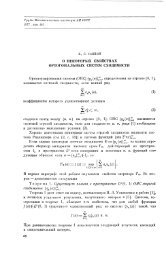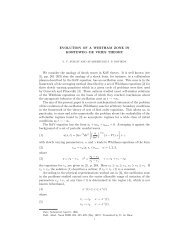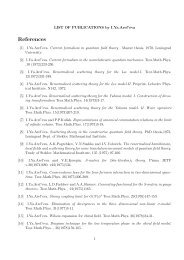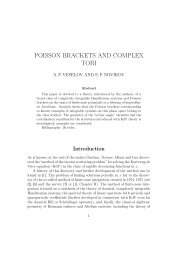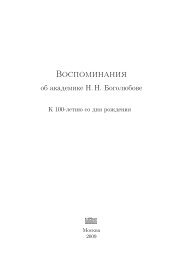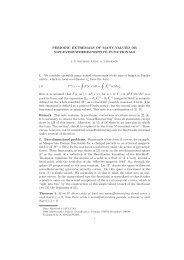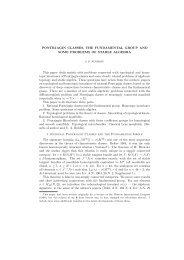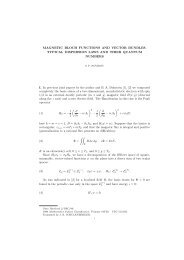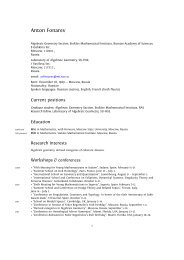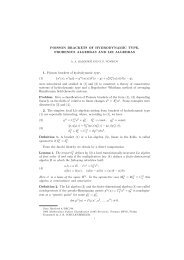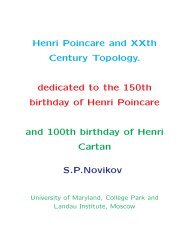6 S. P. NOVIKOVzeros (<strong>the</strong> spectral points) k n = iκ n in <strong>the</strong> upper half plane x n > 0 by <strong>the</strong> <strong>for</strong>mulaa = ∏ k−iκ jj k+iκ j, whereby to a single soliton u(x − ct) <strong>the</strong>re corresponds a singlespectral point k 1 = iκ 1 , where κ 2 1 = +c/4 (cf. [5]). What is <strong>the</strong> right analog of multisolitonsolutions in <strong>the</strong> <strong>periodic</strong> <strong>problem</strong>? We suppose that <strong>the</strong> <strong>periodic</strong> potentialu is such that it has only a finite number of zones; this means that starting fromsome number n > n 0 all points of both spectra a R = ±1 are doubly <strong>de</strong>generate andthat <strong>the</strong> entire half line k 2 ≥ kn 2 0<strong>for</strong>ms a single zone. The <strong>de</strong>generacy condition<strong>for</strong> a spectral point is <strong>the</strong> condition b(k n , x) ≡ 0 <strong>for</strong> kn 2 ≥ kn 2 0. On multiplying <strong>the</strong>period T by an integer T → mT <strong>the</strong> entire zone is filled out by <strong>de</strong>generate levelsb ≡ 0 as m → ∞. On <strong>the</strong> o<strong>the</strong>r hand, with correct passage to <strong>the</strong> period T → ∞,whereby <strong>the</strong> potential u T (x) with period T tends to a rapidly <strong>de</strong>creasing potential<strong>for</strong> T → ∞, <strong>the</strong> zones of finite size contract to isolated points of <strong>the</strong> discretespectrum. All this indicates that it is natural to suppose that <strong>the</strong> right analog ofmultisoliton solutions are <strong>the</strong> finite-zone potentials. The property that a potentialbe a finite-zone potential is conserved in time by virtue of <strong>the</strong> KV equation. Howshould one seek such solutions of <strong>the</strong> KV equation? What are finite-zone potentialslike?We consi<strong>de</strong>r <strong>the</strong> “higher KV <strong>equations</strong>” of or<strong>de</strong>r n˙u = d ( )δIndx δu(x) + c δI n−11δu(x) + · · · + c δI 0n , (6)δu(x)where I n = ∫ P n (u, u ′ , . . . , u (n) ) dx is a polynomial integral of <strong>the</strong> KV equationand c 1 , . . . , c n are arbitrary constants. Equation (6) has or<strong>de</strong>r 2n + 1 and by <strong>the</strong><strong>the</strong>orem of Lax and Gardner [6, 7] it admits <strong>the</strong> Lax representation˙L = [L, A n + c 1 A n−1 + · · · + c n A 0 ], (7)where L = −(d 2 /dx 2 ) + u and <strong>the</strong> operators A 0 , A 1 , A 2 are indicated in <strong>the</strong> introduction,A 0 = (d/dx). We shall now indicate <strong>the</strong> corollary of <strong>the</strong> Zakharov–Fad<strong>de</strong>ev<strong>the</strong>orem mentioned in <strong>the</strong> introduction which, while not noted by <strong>the</strong>m, is extremelyimportant <strong>for</strong> our subsequent purposes.Proposition 2.1. The set of all fixed points (stationary solutions) of any one of <strong>the</strong>higher KV <strong>equations</strong> is an invariant manifold also <strong>for</strong> any o<strong>the</strong>r of <strong>the</strong> higher KV<strong>equations</strong> (in particular, <strong>for</strong> <strong>the</strong> original KV equation) consi<strong>de</strong>red as a dynamicalsystem in function space.Proof. All <strong>the</strong> higher KV <strong>equations</strong> are Hamiltonian systems; <strong>the</strong> Poisson bracketsof <strong>the</strong> integrals are equal to zero [I n , I m ] = 0 <strong>for</strong> all n, m. There<strong>for</strong>e, all <strong>the</strong> higherKV <strong>equations</strong> commute as dynamical systems in function space. There<strong>for</strong>e, <strong>the</strong> setof fixed points <strong>for</strong> one of <strong>the</strong>m is invariant with respect to all <strong>the</strong> remaining ones.This proves Proposition 2.1.□We have <strong>the</strong> following basic <strong>the</strong>orem:Theorem 2.1. 1) All <strong>the</strong> <strong>periodic</strong> stationary solutions of <strong>the</strong> higher KV <strong>equations</strong>( n)d ∑ δI n−ic i = 0 (8)dx δu(x)are potentials u(x), <strong>the</strong> number of zones of which does not exceed n.i=0
THE PERIODIC PROBLEM FOR THE KORTEWEG–DE VRIES EQUATION 72) The equationδI n nδu(x) + ∑ δI n−ic iδu(x) = d (8′ )i=1is a completely integrable Hamiltonian system with n <strong>de</strong>grees of freedom <strong>de</strong>pendingon (n+1) parameters (c 1 , . . . , c n , d), whereby <strong>the</strong> collection of n commuting integralsof this system and all <strong>the</strong> parameters (c 1 , . . . , c n , d) are expressed in terms of 2n +1non<strong>de</strong>generate eigenvalues of both spectra of <strong>the</strong> potentials u(x) which <strong>for</strong>m <strong>the</strong>boundaries of <strong>the</strong> zones.Proof. As is known, in <strong>the</strong> case of rapidly <strong>de</strong>creasing functions u(x) from <strong>the</strong> Laxrepresentation ˙L = [A, L] it is easy to <strong>de</strong>rive an equation <strong>for</strong> <strong>the</strong> eigenfunctions ψ kof <strong>the</strong> operator L: ψ k = Aψ k + λψ k . In <strong>the</strong> <strong>periodic</strong> case <strong>the</strong> analogous <strong>de</strong>rivationgivesψ k = Aψ k + λψ k + µ ¯ψ k ,˙¯ψ k = A ¯ψ k + ¯µψ k + ¯λ ¯ψ k , (9)where λ + ¯λ = 0.In<strong>de</strong>ed, (L − k 2 )ψ k = 0. There<strong>for</strong>e,0 = ˙Lψ k + (L − k 2 )ψ k = (AL − LA)ψ k + (L − k 2 )ψ k = (L − k 2 )(ψ k − Aψ k ).Since (L − k 2 )ψ k = (L − k 2 ) ¯ψ k = 0, we obtain <strong>the</strong> <strong>de</strong>sired result with unknowncoefficients λ(x 0 , t), µ(x 0 , t). To <strong>de</strong>termine <strong>the</strong> coefficients we make use of <strong>the</strong> factthat ψ k (x 0 , x 0 ) = ψ ′ k (x 0, x 0 ) = 0. From this <strong>for</strong> x = x 0 we have(Aψ k ) x=x0 + λ + µ = 0, ( ˙ψ k ) x=x0 = 0,( ) ddx Aψ k + ik(λ − µ) = 0, ( ˙ψ k) ′ x=x0 = 0x=x 0in <strong>the</strong> basis ψ k , ¯ψ k . (In <strong>the</strong> basis φ k , ¯φ k it is necessary to let k ↦→ 1 in <strong>the</strong> lowerequation.)( ) λ µWe consi<strong>de</strong>r <strong>the</strong> matrix Λ =¯µ ¯λ , where λ+¯λ = 0. This is a matrix of <strong>the</strong> Liealgebra of <strong>the</strong> group SU 1,1 to which <strong>the</strong> monodromy matrix T (k, x 0 ) belongs. Thematrix Λ, as is evi<strong>de</strong>nt from Eq. (10), <strong>de</strong>pends on u(x 0 , t), u ′ (x 0 , t), . . . , u (2n) (x 0 , t), k.In or<strong>de</strong>r to study <strong>the</strong> time <strong>de</strong>pen<strong>de</strong>nce of <strong>the</strong> monodromy matrix T (k, x 0 ) byEq. (6) it is necessary to compute ψ k and ψ ′ at <strong>the</strong> point x = x 0 + T , where T is<strong>the</strong> period. Having done this we obtain (x = x 0 )ȧ + ḃ = A(aψ k + b ¯ψ k ) + λ(aψ k + b ¯ψ k ) + µ(¯bψ k + ā ¯ψ k ),ik(ȧ − ḃ) = ddx A(aψ k + b ¯ψ k ) + λ(aψ k ′ + b ¯ψ k) ′ + µ(¯bψ k ′ + ā ¯ψ(11)k).′Substituting relation (10) into (11) and per<strong>for</strong>ming simple computations, we obtain(10)ȧ = µ¯b − b¯µ, ȧ + ˙ā = 2ȧ R = 0, ḃ = (λ − ¯λ)b + (a − ā)µ = 2λb + 2ia I µ. (11 ′ )Proposition 2.2. On <strong>the</strong> basis of <strong>the</strong> higher KV equation <strong>the</strong> <strong>de</strong>pen<strong>de</strong>nce of <strong>the</strong>monodromy matrix on time is <strong>de</strong>scribed by <strong>the</strong> equation˙ T = [Λ, T ], (12)where <strong>the</strong> matrix Λ is found from <strong>for</strong>mula (10) starting from <strong>the</strong> time <strong>de</strong>pen<strong>de</strong>nceof <strong>the</strong> eigenfunction basis (ψ k , ¯ψ k ):( ˙ψ k , ˙¯ψk ) = A(ψ k , ¯ψ k ) + Λ(ψ k , ¯ψ k ).



